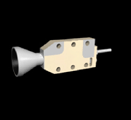Channel Electron
Mulitipliers

What you
need to know to select the right Channel Electron Multiplier.
Channel electron multipliers (or Channeltron * as they are sometimes
called) are high gain devices for amplifying a range of electronic
signals under a vacuum environment.
Typical channel electron multipliers will amplify electrons by
gains of up to 10 to power 8. These devices can amplify very
weak signal sources and can be used to detect a wide range of
particles such as electrons, protons, UV photons and very low
energy X-rays.
What types of electron multipliers are available?
The electron multipliers fall into two groups:-
1. 1) Single channel electron multipliers in either glass or
ceramic
2. 2) Micro channel electron multiplier plates
What are the benefits of each of these types?
If you want to do purely particle counting or current amplification
then
the single channel electron multiplier is the device to use.
It is a single
amplifying channel usually in the shape of a spiral which can
amplify each incoming electron by up to 10 to the power 8.
A micro channel plate is used normally where spatial data is
required and
its prime use is in night viewing devices such as night viewing
goggles or
weapon sights. They are also used in some types of mass spectrometers.
Their gain is generally lower than single channel types typically
no more
than 10 to power 4.
What is the difference between ceramic and glass electron multipliers?
Historically glass multipliers have been lower in price than
ceramic types
however that difference has been eroded in recent years and the
ceramic ones are now only slightly more expensive. However if
price is the main consideration the glass ones are still cheaper.
Technically the two types are very similar in performance. The
ceramic
ones are more sturdy and robust particularly on the larger coned
types.
Also the ceramic ones are more easily built into arrays. The
mounting of
the glass multipliers needs to be done with great care to ensure
the cones are not damaged or broken.
How do I mount micro channel plates?
The mounting of micro channel plates is not easy. Unless you
have
experience at doing this you may like to buy a ready mounted
assembly
from us. Please inform one of our sales staff of your requirements.
We
will be pleased to prepare a quote for you. We can offer single
or double
plate arrays with phosphor screen or high resistive anode output
if required.
We can also mount the whole assembly on a "conflat"
flange.
The advantage of mounting two channel plates in tandem is to
increase
the gain of the micro channel plate assembly to somewhere in
the order
of 10 to power 7.
If you wish to mount your own channel plates take great care
to make
the electrical contacts well as poor electrical contacts will
increase the
noise and other effects greatly.
What are the typical applications for single channel electron
multipliers?
This type of multiplier is used in
 Space applications
Space applications
 Scientific experiments in pulse
counting
Scientific experiments in pulse
counting
 Current amplification
Current amplification
 Mass spectrometers
Mass spectrometers
 Time of flight spectrometers
Time of flight spectrometers
It is worthwhile mentioning that there are two types of single
channel
electron multipliers. Analogue and pulse counting types. The
analogue
multipliers have been designed for mass spectrometer. Have considerably
lower resistance from the conventional pulse counting types and
give maximum collection efficiency at the output of the multiplier.
Most of this series of multipliers are provided with a collector
assembly and have a mount that is specifically designed for mounting
into the spectrometer system.
What are the typical applications for micro channel plates?
Micro channel plates are used in
 Night vision goggles
Night vision goggles
 Night vision scopes
Night vision scopes
 Weapon Sights
Weapon Sights
 Mass spectrometers
Mass spectrometers
 Atomic force spectrometers
Atomic force spectrometers
 Time of flight spectrometers
Time of flight spectrometers
How can I power my electron multipliers?
All electron multipliers are high voltage but a lower current
device so
power consumption is very low. While the typical operating voltage
can
be in the range of 1200 - 1800 volts the output current is just
a few
micro amps so the overall power consumption is extremely low.
What sizes of electron multipliers and micro channel plates
are available?
Electron multipliers are available with input cone diameters
from 2mm to
15mm diameter. They are also available with a number of different
channel diameters and analogue multipliers for mass spectrometer
applications can be provided with metal/ceramic housings. Typical
channel length to diameter is around 120:1
Micro channel plates have surface areas typically of 25, 36 and
46mm
diameter although other sizes are also available and up to 100
x 100mm
square plates are offered. Typical channel length to diameter
ratios are
40:1 which is commonly called single thickness plates however
80:1 types are also offered ( commonly known as double thickness)
By using double thickness plates you can ensure the input particles
are fully saturated in the channels of the multiplier. Plates
normally have around 10-12 micron channel diameters and the channels
are set at an angle of around 13 deg to the perpendicular face.
* NB: All trademarks used in this article are acknowledged.
If you wish to download a copy of this article, click here...
This article
has been kindly supplied by: ALRAD


Space applications
Scientific experiments in pulse counting
Current amplification
Mass spectrometers
Time of flight spectrometers
Night vision goggles
Night vision scopes
Weapon Sights
Mass spectrometers
Atomic force spectrometers
Time of flight spectrometers